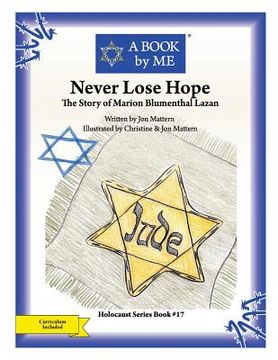Reseña del libro "Never Lose Hope: The Story of Marion Blumenthal Lazan (en Inglés)"
Marion Blumenthal was born December 20, 1934 in Bremen, Germany. She had a loving home with her parents, Ruth and Walter; her older brother Albert; and her grandparents, whom she called by the German words for Grandma and Grandpa-Oma and Opa. The German people had struggled since their defeat in the World War I. Hitler was a dynamic speaker and succeeded in engaging the enthusiasm of many Germans with his promises to restore Germany's honor, expand its territory, and bring prosperity. As the Nazis gained power, they suppressed opposition to their program, until it was almost impossible to oppose them without going to jail-or worse. The Nazi Party's ideology included hatred for Jews, gypsies, homosexuals, and more. Hitler ordered a boycott of all Jewish businesses. Jews were banned from restaurants and theaters. They could no longer own property, including cars or boats. Jewish children could not attend public schools. There was a curfew and all Jewish citizens had to be off the streets. It was hard for Marion's family to understand how people could turn their backs on their Jewish neighbors. Not all Germans agreed with Hitler, but few had the courage to defy him. On November 9, 1938, the Gestapo came to their door and ordered Marion's father to come with them. Marion's mother did not know where he was taken or if he would come home. Her fears increased because that night, synagogues were destroyed, holy books burned, and Jewish-owned shops and homes ransacked. This terrible event became known as "Kristallnacht,"-The Night of Broken Glass. Eleven days later, Walter returned from Buchenwald but would not talk about what happened. It was clear they needed to escape Germany so they made their home in Westerbork, a permanent refugee camp. Marion remembers playing her favorite games-jump rope, hopscotch, and marbles. Fifteen months later they received good news: they would be going to America! By May 1940 their hopes were dashed. No ships could sail from Rotterdam because the Nazis had bombed the Dutch city. Westerbork became a deportation camp, which sent Jews to the notorious concentration camps. Jews were ordered to wear the yellow Star of David on their clothing. When Marion was nine, her family was sent on an overcrowded train to the dreaded concentration camp at Bergen-Belsen. Food was a so-called "cabbage soup," consisting of turnips, potato peelings, and meat gristle. Marion picked lice from her body, hair, and clothes because typhus, a lice-borne disease, could easily spread in the damp, overcrowded camps. To keep up her spirits and hope, she hunted for special pebbles, telling herself that finding four perfect pebbles would mean her family would survive. April 23, 1945 was liberation day. Marion was ten years old and weighed 35 pounds when they were liberated by the Russians. They moved into an abandoned farmhouse where sweet jam, meat, and cheese were plentiful. They had both their freedom and food to eat but sadly, Papa died of typhus in June. Marion's mother never gave up hope that they would make it to America. Then Ruth Blumenthal received good news! They could leave for America. Marion was overwhelmed with joy and gratitude when she first saw the Statue of Liberty. They received news that they would relocate to Peoria, Illinois. School was difficult because the children had missed so much. But they persevered, and each day life became easier. In 1953, Marion graduated from Peoria Central High School, ranking eighth in her class of 265 students. She met a young man named Nathaniel Lazan and they married August 2, 1953. They reside in New York, and have three children, nine grandchildren and two great-granddaughters. Marion speaks about her Holocaust experience to students worldwide. She is the author of Four Perfect Pebbles, a detailed memoir of those devastating years and how she found hope in the horror.

